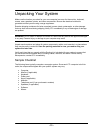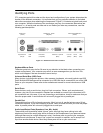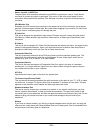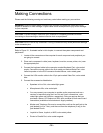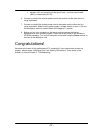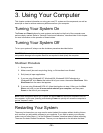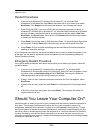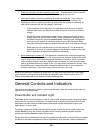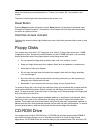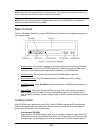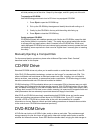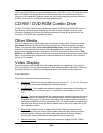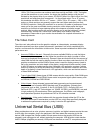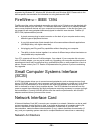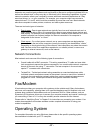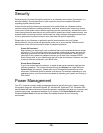
- 21 -
follow the shutdown procedure described in “Turning Your System Off,” found earlier in this
chapter.
The power indicator light illuminates whenever the system is on.
Reset Button
Pressing Reset forces the computer to reboot. Reset should only be used as described under
“Emergency Restart Procedure,” found earlier in this chapter to avoid losing data and possible
corruption of system boot files.
Hard Disk Access Indicator
The hard disk access indicator light flashes every time a hard disk performs either a read or write
operation.
Floppy Disks
Your system may come with a 3.5” floppy disk drive. Most 3.5" floppy disks store up to 1.44MB
(megabytes) of data, though some older diskettes only store 760KB (kilobytes). You must take
several precautions when using floppy disks to avoid losing stored data:
• Do not expose the floppy disk to extreme heat, cold, sun, moisture, or dust.
• Keep your floppy disks away from magnetic fields (such as speakers or transformers).
• Never bend or twist your floppies.
• Do not open the metal door that shields the magnetic disk within the floppy assembly.
You may damage it.
• Be sure to take any other environmental or security precautions you feel necessary to
safeguard your floppies and their data.
• Remember: If your computer can read your floppy, so can anyone else's!
To access a floppy disk, insert it with the metal door facing up and towards the computer and the
round metal spindle facing down. Slide it smoothly into the floppy drive slot until it clicks into
place. To remove the disk, press the button on the floppy drive. Grasp the edge of the floppy and
slide it smoothly out of the drive.
To protect the data on floppies against accidental deletion or modification, find the small sliding
plastic tag in the corner on the underside of the floppy and press it towards the middle of the
diskette. This enables the write-protect feature that prevents data from being added, modified, or
deleted from the disk. Write-protected diskettes may be read and their data accessed. To remove
the write-protect feature, slide the small plastic tab towards the edge of the diskette.
CD-ROM Drive
Your system may include a CD-ROM drive. A CD-ROM disk provides approximately 650MB of
non-volatile read-only storage and is an ideal delivery medium for many of today’s large
applications. All CD-ROM drives also have the ability to play standard audio CDs, and many CD-



